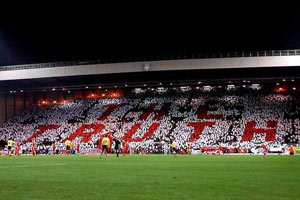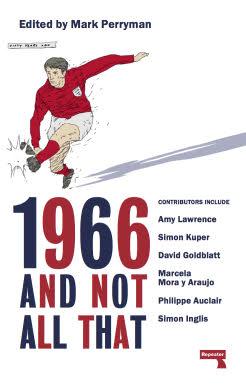
Football’s Greatest Hurt of All
28.04.16
Mark Perryman argues Hillsborough needs to be understood not just as a human tragedy but as a consequence of how football was changing whilst the golden moment of 1966 faded in the popular memory of the late 1980s.
 One year after Hillsborough was Italia ’90. Fondly remembered today for Gazza’s tears, an evening, or three with Gary Lineker and the culture clash of Pavarotti’s Nessum Dorum vs New Order’s World in Motion.
One year after Hillsborough was Italia ’90. Fondly remembered today for Gazza’s tears, an evening, or three with Gary Lineker and the culture clash of Pavarotti’s Nessum Dorum vs New Order’s World in Motion.
But the actuality of the time was that up to the semi-final against you know who as a tournamen Italia '90 was dominated by what had become known as ‘The English Disease’. For the preceding five years all English club sides had been banned from European competition, an unprecedented punishment following crowd trouble involving Liverpool fans at the Heysel European Cup Final resulting in the death of 39 Juventus fans. This was an era when going to football required an unavoidable clash with trouble. Mass arrests, games dominated by what FA Chairman Sir Andrew Stephen described in 1972 as “the madness that takes place on the terraces”. Pitch invasions, games halted and abandoned. Riots accompanying European away trips, in 1974 Spurs Manager Bill Nicholson after one famously pleaded with his supporters “This is a football game –not a war.” Not for some it wasn’t. Mounted police deployed on the pitch to keep some semblance of order. In 1977 Man Utd were forced to play a ‘home’ European tie at Plymouth Argyle’s ground, the furthest away possible from Old Trafford but still in England, punishment for their rioting fans. The FA fined because of the riotous misbehaviour of England fans at tournaments. Players knocked unconscious by missiles thrown from the terraces. Games forced to be played behind closed doors. Fatalities. In 1985 the Bradford stadium fire, 56 deaths. On the same day a teenager dies at St Andrews when fighting breaks out between Leeds and Birmingham City fans.
Not nice, but hardly a surprise, The Sunday Times after the Bradford fire described football as “a slum sport played in slum stadiums increasingly watched by slum people, who deter decent folk from turning up.” It had taken less than two decades for English football’s 1966 golden moment to lose almost all its shine. Following the failures to qualify for the 1974 and 1978 World Cups England on the pitch finally made it to the 1980 European Championships hosted by Italy. The team were more or less back to the pre-1966 standard, finishing third in their Group and thus failing to make it to the semi-final played between the two Group winners and runners-up. It was off the pitch that the huge change in what England had become since ’66 was most evident. Other countries had a domestic hooligan problem, however this era England was virtually unique in exporting it to make trouble at Euros and World Cups. It was an unwelcome side show that would more or less persist through to Euro 2000 twenty years later until a seismic change in England fan culture occurred faraway amongst the 10,000 England fans who travelled out to Japan 2002 and England abroad has never been the same old, bad old, ever since.
One of the architects of the successful organisation of World Cup 1966, now Shadow Minster of Sport, Denis Howell found himself describing England fan trouble at Euro ’80 as a “National Disaster”. He wasn’t alone, when asked to comment on his team’s fans England Manager Ron Greenwood described them as “Bastards.” Suggesting “I hope they put them in a big boat and drop them in the ocean half-way back.” FA Chairman Harold Thompson added his own description of England supporters “ Sewer-rats.” This was the dominant discourse around what it mean to follow England for the fifty years’ of hurt middle two decades 1980-2000. For a long time few would challenge it as Stuart Weir bravely did writing for the then sociology house journal New Society reporting from the England away end at Italy ‘80.
“ The Italian police were slow to react, but made up for that by the extreme nature of their reaction. First, squads of police ran out of one of the tunnels and waded into any English fan within reach, regardless of whether they were involved in the affray or not. Shortly afterwards, riot police lined up on the other side of the moat and fired tear gas canisters into the great mass of English supporters in red, white and blue, who were nowhere near the original fracas.”
Weir accurately locates the skewering of the discourse in terms of the class relations already underpinning modern football twelve years before the abomination the Premier League would become.
“ Football is a popular sport, but it belongs to the world of Mrs Thatcher, Howell and Sir Harold, not to the fans. Though workers formed and ran many of the leading clubs, they and the game’s major institutions - the FA and Football League - are now remote from the fans who keep the game going. The clubs are under the control of local business elites who restrict the participation of their followers to separate supporters’ clubs. The young fans get the worst deal. They are herded about with scarcely any respect. If they travel to away games, they are kept strictly segregated at all times and often end up in a pen at the home ground, with a poor view of the match.”
James Erskine’s superb documentary film of Italia 90 One Night in Turin, heavily based on the peerless Pete Davies book of the same tournament All Played Out,memorably opens with a long sequence of violent crowd trouble.Except this wasn’t anything to do with football it was the Trafalgar Square Poll Tax riot of earlier that summer. I can still remember this Saturday afternoon. Shamefully as someone who prides himself on his leftwing principles I can’t claim to have been marching and demonstrating myself. Instead I was in a West End cinema and when the closing credits rolled a concerned box office manager appeared on stage to announce it was unsafe for anyone to leave. The West End was in flames with every plate glass window in the vicinity smashed to smithereens. Later that night on the tube home I listened in to conversations of groups of lads who’d also been held up, this time from leaving home games across the capital and regretting they’d missed out on all the violent fun.
The football violence of the 1980s cannot be entirely divorced from a period not just of increasing social division but mass mobilisation and more than occasional public disorder. Huge CND marches and associated direct action, 1981 inner-city riots at Brixton and Toxteth but elsewhere too, Derek Hatton in Liverpool, Ken Livingstone at the GLC, David Blunkett’s Socialist Republic of South Yorkshire, the 1984-85 Miners strike, followed by the weekly night-time siege of the new Rupert Murdoch HQ at Wapping. There was an ongoing mainland IRA campaign with the Brighton Grand Hotel Bombing in 1986 arguably its most breathtaking operation of all. In 2009 the New Statesmanpublished a special edition to mark the 30th anniversary of 1989 which it dubbed ‘The Year of the Crowd.’ It ranged over the fall of the Berlin Wall, the Tiananmen Square Massacre and the frenzy in Tehran amongst the huge numbers turning out for the Ayatollah’s funeral.
England? Hillsborough, just another Liverpool FA Cup semi-final but a day that ended with fans dying simply because they wanted to watch their team. Andrew Hussey contributed the Hillsborough essay in which he makes the following key point to describe the images and memories of Liverpool’s Kop and the fans who stood and sang their hearts out for their team:
“This was the mob, the crowd, the working class in a group and in action, but it was nothing to be feared. The humour and dignity of this crowd were iconic. These images announced to the world the cultural vibrancy of ordinary people and their pleasures. To this extent, Liverpool fans were as crucial a component of 1960s pop culture as the Beatles.”
Of course as everyone knows the Beatles were bigger than God. But that depth of warm appreciation had been hollowed out by the harsher climate of the 1980s as Hussey succinctly explains :
“ By the end of the Thatcherite 1980s this same crowd had become the object of scorn and derision. To be working class, to be a football fan, to be unemployed and northern was to be scum.”
And 96 died.
During the 1980s fans’ behaviour was met with legislative and media mood swings between the uselessness of platitudes and inertia to moral panic and the clamour for the punitive. Those who were in a position to do something ended up doing nothing. The worsening conditions at grounds just got worse, the policing not much better, crowd safety measures close to non-existent, the rising tide of racism looked away from in the hope that it might go away, or not even caring if it did or didn’t. To go to football at least for some was to know something was seriously wrong.
This is an edited extract from Mark Perryman’s new book 1966 and Not All That, published by Repeater Books in mid-May available pre-publication from here.
